

ACLUMP Land Use Mapping -Department of Agriculture. Land use mapping in Australia is conducted broadly at two scales: national scale and catchment scale (see Figure 1).
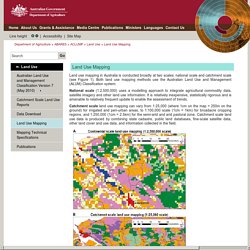
Both land use mapping methods use the Australian Land Use and Management (ALUM) Classification system. National scale (1:2,500,000) uses a modelling approach to integrate agricultural commodity data, satellite imagery and other land use information. It is relatively inexpensive, statistically rigorous and is amenable to relatively frequent update to enable the assessment of trends.
Catchment scale land use mapping can vary from 1:25,000 (where 1cm on the map = 250m on the ground) for irrigated and peri-urban areas, to 1:100,000 scale (1cm = 1km) for broadacre cropping regions, and 1:250,000 (1cm = 2.5km) for the semi-arid and arid pastoral zone. Catchment scale land use data is produced by combining state cadastre, public land databases, fine-scale satellite data, other land cover and use data, and information collected in the field.
A. B. USA History of Land Use Regulation. Overview Land use planning is not a new concept- in fact, there are land use regulations that date to medieval time in Europe.

In the United States, there are several key pieces of legislation that have shaped land use law as we know it today. Standard State Enabling Act & Standard City Planning Enabling Act In 1921, an Advisory Committee on City Planning and Zoning was created by Secretary of Commerce Herbert Hoover. The advisory committee was tasked with drafting model planning and zoning statutes that could then be adopted by states. African Wildlife Foundation. Overview Wherever people use land, land-use planning is happening—consciously or not.

Our goal at African Wildlife Foundation is to make land use a deliberate, planned process benefitting people, wildlife, and the land itself. Land-use planning should enhance rural development, wealth creation, food security, sustainability of resources, and equity. Countries using Smart Growth. Historical approach to Land Use Planning. 2005 National Award for Smart Growth Achievement. On this page 2005 Award Winners Overall Excellence in Smart GrowthHighlands' Garden Village Denver Urban Renewal Authority, Denver, Colorado Built ProjectsBelmar City of Lakewood and Lakewood Reinvestment Authority, Lakewood, Colorado Policies and RegulationsCentral District Specific Plan City of Pasadena Planning and Development Department, Pasadena, California Small CommunitiesGilbert & Bennett Wire Mill Redevelopment Town of Redding, Redding, Connecticut Military Base RedevelopmentBaldwin Park City of Orlando, Orlando, Florida Top of Page A Message from the Administrator Stephen L.
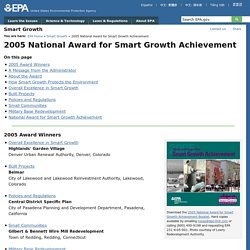
Congratulations to the winners of the Environmental Protection Agency's 2005 National Awards for Smart Growth Achievement! At EPA we are proud of the gains in environmental protection that have been made over the past 35 years, but also recognize that 21st century environmental challenges require new approaches beyond the old model of mandates, rules, and regulations. The Ahwahnee Principles - Local Government Commission. Cities everywhere are facing similar problems – increasing traffic congestion and worsening air pollution, the continuing loss of open space, the need for costly improvements to road and public services, the inequitable distribution of economic resources, and the loss of a sense of community.
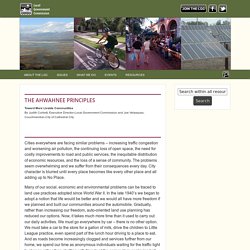
The problems seem overwhelming and we suffer from their consequences every day. City character is blurred until every place becomes like every other place and all adding up to No Place. Many of our social, economic and environmental problems can be traced to land use practices adopted since World War II. In the late 1940’s we began to adopt a notion that life would be better and we would all have more freedom if we planned and built our communities around the automobile. 'Smart Growth' zone passes - The Daily News of Newburyport. NEWBURYPORT — City councilors spoke with urgency Tuesday night when they passed the first reading of an amended zoning ordinance approving a “Smart Growth” zone, but municipal officials say that actual changes could take several years to be seen.
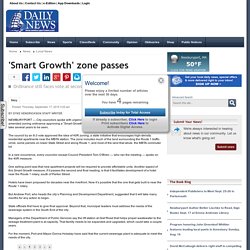
The council by an 8-3 vote approved the idea of 40R zoning, a state initiative that encourages high-density residential apartments near the MBTA station. The zone includes much of the land surrounding the Route 1 traffic circle, some parcels on lower State Street and along Route 1, and most of the land that abuts the MBTA commuter lot.
In a rare occurrence, every councilor except Council President Tom O’Brien — who ran the meeting — spoke on the 40R measure. One selling point was that new apartment projects will be required to provide affordable units. EPA Recognizes Three Communities for Smart Growth Achievement. Release Date: 09/16/2015Contact Information: Enesta Jones jones.enesta@epa.gov 202-564-7873 202-564-4355 WASHINGTON – The U.S.
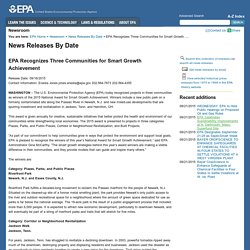
Environmental Protection Agency (EPA) today recognized projects in three communities as winners of the 2015 National Award for Smart Growth Achievement. F.C. Should Learn from Arlington’s ‘Smart Growth’ By Suzanne Smith Sundburg Charlie Clark’s column in the August 26 News-Press on Arlington parkland highlights the harsh realities resulting from decades of poor planning and unwise land use.
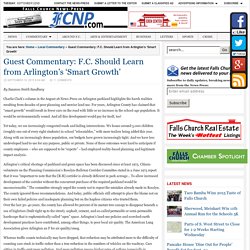
For years, Arlington County has claimed that “smart growth” would result in fewer cars on the road with little or no increase in the school-age population. It would be environmentally sound. And all this development would pay for itself, too! Yet today, we see increasingly congested roads and failing intersections. Arlington’s critical shortage of parkland and green space has been discussed since at least 1975. Whereas traffic counts technically may have dropped, that reduction may be attributed more to the difficulty of counting cars stuck in traffic rather than a true reduction in the numbers of vehicles on the roadway. “Smart growth” as applied in Arlington has been deeply flawed. Smart growth to be focus of forum -NZ.
Phil Green, a driving force behind the bi-monthly Urban Design Cafe Series, is aiming to hold a major forum in Tauranga next February.
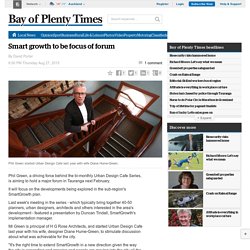
It will focus on the developments being explored in the sub-region's SmartGrowth plan. Last week's meeting in the series - which typically bring together 40-50 planners, urban designers, architects and others interested in the area's development - featured a presentation by Duncan Tindall, SmartGrowth's implementation manager. Mr Green is principal of H G Rose Architects, and started Urban Design Cafe last year with his wife, designer Diane Hume-Green, to stimulate discussion about what was achievable for the city. "It's the right time to extend SmartGrowth in a new direction given the way the city is expanding and growing and people are moving into the city all the time," said Mr Green. The city could see a mix of intensified urban living with multi-unit apartments, as well as more suburbs.
Zoning makes the difference : Rutland Herald Online. Zoning makes the difference September 21,2015 Zoning makes the difference Congratulations to the Town of Wallingford on the adoption of their new zoning bylaw.
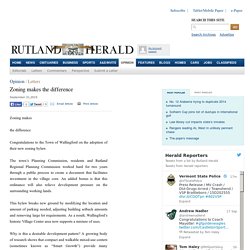
The town’s Planning Commission, residents and Rutland Regional Planning Commission worked hard for two years through a public process to create a document that facilitates investment in the village core. This bylaw breaks new ground by modifying the location and amount of parking needed, adjusting building setback amounts and removing large lot requirements. Why is this a desirable development pattern? For example: -Mixed-use downtown development generates 10 times the tax revenue per acre, saves 38 percent on upfront infrastructure costs per unit, and saves 10 percent on ongoing delivery of services compared to sprawl, according to Smart Growth America’s 2013 report Building Better Budgets. Wallingford’s new zoning ordinance allows investment and development patterns that are desired by Wallingford residents. Healthy Spaces & Places. The Health Costs of Urban Sprawl.
Healthy Parks, Healthy People. Australian Rural Planning. Environmental Damage. Australia can cope with population growth. We just need smart planning. My colleague Kelvin Thomson recently issued a "14-point plan for population reform" in which he argued that Australia's environment and infrastructure cannot cope with a population of 35 million by the year 2050, which has been forecast by Treasury. Thomson suggested a cut to the skilled migration intake and a freeze on the family reunion intake (while increasing our refugee intake). Although I agree that concerns about environment and infrastructure are legitimate reasons for questioning population growth, I believe such concerns can be mitigated. Minimal growth should not be our aim. Continued high population growth is an almost uniquely Australian issue.
SmartGrowth Unlocking Smart Growth in Australia's Capital Cities. Land Use Planning: Urbis. Urbis is an interdisciplinary consulting firm offering services in planning, design, property, social planning, economics and research. Working with clients on integrated or standalone assignments, Urbis provides the social research, analysis and advice upon which major social, commercial and environmental decisions are made.
It is our unique mix of services that provides us with the property market insight that gives our clients that competitive advantage. Urbis provides expertise in: State Land Use Planning in Rural Areas. Land use and natural ecosystems: A revolution in land use is the key to a sustainable landscape. Land-Use Planning - river, effects, important, system, source, effect, human. Recognising the true economic effects of land-use planning. What was the problem? Land-use planning has traditionally focused on design, physical measures and narrowly defined environmental effects. But the decisions that planners make have an economic impact too — on the supply and affordability of houses and offices, for instance, and on the productivity of economic users of space, such as supermarkets.
The challenge is to design planning policies that are better in terms of economic efficiency but deliver as good or better environmental impacts. What did we do? Impacts of Improper Land Uses in Cities on the Natural Environment and Ecological Landscape Planning. 1. Introduction Irregular and unsound urban development is the common problem of all urban settlements today. The increasing continuation of this problem is inevitable in this order, where the economy-ecology balance is not taken into consideration and economic concerns always win. Urban growth, the density of which is continuing increasingly with the population increase that has taken place in urban areas in the recent years, leads to the vanishing of an extremely limited number of natural resources and to the occurrence of irregular and unsound urban areas, along with impairing the agricultural lands (Brueckner et al., 2001).
When considered from another perspective, it might be stated that urbanization gained momentum with the industrial revolution. It is impossible to make up for the natural resources which have been used up due to the degraded ecosystem; furthermore, the vital impacts of this process are increasing day by day. 2. 3. 4. Table 2 5. What is land use planning? definition and meaning. What is "smart growth?" Smart growth is a better way to build and maintain our towns and cities. Natural Resources Examples. Login. Land Use Planning Principles Help You Discuss Future Development. Investigating the impact of a smart growth community on the contexts of children's physical activity using Ecological Momentary Assessment.
Guidelines for land-use planning. Evaluating Smart Growth Benefits and Costs. This is the third in a series of columns that respond to recent claims by the National Association of Home Builders (NAHB) that smart growth policies are ineffective and harmful.